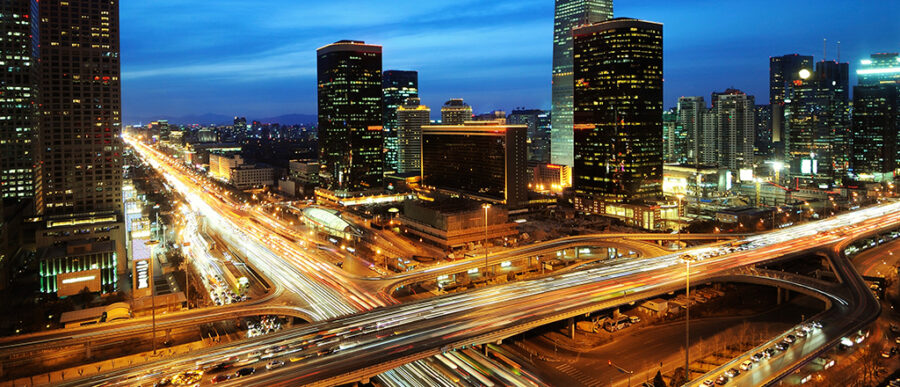For much of the past year, Chinese President Xi Jinping has been urging his country to stay cool in the face of China’s “new normal” of slower economic growth. “We must boost our confidence, adapt to the new normal conditions based on the characteristics of China’s economic growth in the current phase and stay cool-minded,” he said last May. On January 19, the National Bureau of Statistics announced that the country’s 2014 GDP growth rate came in at 7.4% — slightly higher than an expected rate of 7.3%, but below Beijing’s 7.5% target range. This year’s target is set even lower at 7%.
Chinese stocks rose in response to the January 19 announcement, one day after the market saw its biggest drop in six years — an alarming 7.7% — following a crackdown on illegal trading.
In the new normal, China’s GDP growth rate is no longer the most important indicator to watch, especially if authorities can manage the decline without widespread unrest, say Wharton and other experts. Rather, progress on fundamental economic reforms from the Communist Party Central Committee’s Third Plenum in late 2013 is more essential now in the country’s transition from a fast-growing, developing economy based on investment in heavy industry and low-cost, manufactured exports to a more mature economy based on domestic consumption and higher-value goods and services.
Undoing Excesses
“In some respects, it’s inevitable that after 30 years of hyper-growth, the economy is slowing down,” says Marshall Meyer, Wharton emeritus professor of management. “There are only so many railroads and factories you can build, especially when global demand is softening. But changing the country’s business model is hard to do.” Indeed, the “progress [of reform] is much slower than expected,” says Franklin Allen, finance professor at Wharton and at Imperial College in London. If China fails to embrace reforms, “in the long run, the risk is that will hurt the growth rate and the people’s welfare.” The challenge is to avoid the “middle-income trap,” where countries are stuck with low growth and middling GDP without the ability to compete against lower-wage countries or more developed economies.
Spurring the need for reform now are the excesses of China’s post-global financial crisis stimulus, where Beijing kept the economy growing by pumping four trillion renminbi ($586 billion) through local governments to prop up state-owned enterprises, real estate and other investments. The stimulus further entrenched the economy’s reliance on industrial investment, export and frothy real estate for growth, but many of these sectors are now suffering from overcapacity. Moreover, local government investors are now in deep debt. “In retrospect, it’s easy to say: Rather than put money into concrete, put it into the workforce and bolster the social security system,” says Meyer. “Ultimately, household financial security will yield greater dividends than low-cost manufacturing for export. What looked like a surge of prosperity in 2008 to 2009 is coming back to haunt the Chinese economy, making the problem especially difficult.”
“It’s inevitable that after 30 years of hyper-growth, the economy is slowing down. There are only so many railroads and factories you can build, especially when global demand is softening.”–Marshall Meyer
Pain and Hope
For now, even a seemingly small drop from 7.5% to 7.4% GDP growth means pain on the ground, notes Meyer. “Talking to merchants at malls, business is slow; many Beijing restaurants have closed, and hotels seem empty,” he says. Also hard hit are heavy industries, such as steel, cement and chemicals — important to the slumping real estate sector — as well as “low-end manufacturing, now becoming automated or moving to lower-cost inland locations or countries,” says William Adams, senior international economist at PNC Financial in Pittsburgh, Pennsylvania. On the other hand, “because of the one-child policy, China also has far fewer workforce entrants than years ago,” Adams notes, “and more are heading into higher education instead of straight into the workforce after secondary school.”
Many China economic experts are optimistic. Though 2015 is poised to be another difficult year, in large part due to the real estate slowdown, “I’m inclined to believe we are approaching the bottom of the market, and things will turn up better than most expect,” says Pieter Bottelier, senior adjunct professor at Johns Hopkins University’s School of Advanced International Studies (SAIS) in Washington, D.C. “If, indeed, real estate prices and turnover are about to bottom out, that will lead to secondary effects to stimulate higher levels of private and public investment throughout the economy.”
If an upturn in the real estate sector is not in the cards, however, chances of government stimulus are high, says Bottelier. This time, stimulus would likely come directly from the central government, rather than through deeply indebted local governments. China’s National Development and Reform Commission is said to have prepared a $1 trillion plan (seven trillion yuan) for government investment in infrastructure, according to news reports this year. Overall, however, says Bottelier, “the prospect of financial or economic collapse in 2015 is pretty low,” where a relatively strong performance in agriculture and especially in the service sector help protect employment.
Year for Reform?
On the reform front, hopes are also running high. Some signs are emerging that China’s transition is slowly taking hold, say experts. Consumption as share of GDP is growing, and the service sector is now bigger than the manufacturing sector as a percentage of GDP, noted Arthur Kroeber, head of research at the Beijing-based economics research firm Gavekal Dragonomics, at a January 9 Brookings Institution conference in Washington, D.C. He said average annual investment grew 15% a year in 2007 and now is down to about 7% to 7.5%, while consumption, growing at about 8% to 8.5% then, is now at 7.5%. Though consumption has slowed in the soft economy, it has fallen much less than investment, he pointed out. Most important, innovation is taking hold, added Kroeber, citing the global success of Internet giant Alibaba.
Since Xi became President two years ago, though, his anti-corruption campaign has grabbed more headlines than actual economic reforms. The campaign is designed to clear the way for reform by attacking vested interests in the Old Economy that threaten the transition to the New Economy, including cozy relationships between government officials and executives at state-owned enterprises. “The stage is set for picking up the pace for economic reform this year and into the next Five-Year Plan (for 2016-2020),” says Avery Goldstein, director of the University of Pennsylvania’s Center for the Study of Contemporary China and a professor of global politics and international relations. “The open question is whether they put in place institutional reforms that make it less likely that corruption reoccurs after getting rid of the first crop of officials.” The Central Committee’s Fourth Plenum plan of late last year, focusing on changing the legal system, may make the legal system a more effective check on corruption, he notes.
“What looked like a surge of prosperity in 2008 to 2009 is coming back to haunt the Chinese economy.”–Marshall Meyer
In the shadow of anti-corruption efforts, some economic reforms have moved ahead, note experts. Last June, Beijing approved a fiscal reform plan to be implemented by 2016, including measures to make local government budget processes more transparent, a redesign of the tax system and better matching of financial resources with fiscal responsibility between central and local governments — increasing Beijing’s responsibilities, as it receives half of the nation’s revenues and currently shoulders only one-third of its expenditures. Last summer, China also took the first steps to reform its urban hukou system, whereby 100 million rural Chinese may be allowed urban residency in small- to medium-sized cities. In addition, Beijing is lifting controls on pricing for refined petroleum products, natural gas, electricity and water, to incentivize investments and avoid waste.
Putting the Market in the Driver’s Seat
But much-needed reforms in the financial sector are taking longer than expected, even though they are essential if China is to allocate capital to investments more efficiently, say experts. “The Chinese economy could grow faster if [the government] could get a system [of open capital markets] going,” notes Wharton’s Allen. One area to watch is whether the Shanghai Free Trade Zone, an experiment in open financial markets, is allowed to proceed, he says. In November, Beijing took a first step in opening capital markets when it allowed investors in Hong Kong and Shanghai to invest in each other’s stock exchanges, and it may allow the same for Shenzhen and Hong Kong investors, according to Allen. As China integrates into global capital markets, the renminbi (RMB) will start moving to a more freely floating exchange rate, and “we will see bidirectional volatility in the RMB in 2015,” he predicts.
Last November, the People’s Bank of China cut benchmark loan and deposit rates to help small and medium-sized enterprises (SMEs) obtain capital. It also allowed banks to set deposit rates at 20%, instead of 10%, above benchmark rates. In addition, Beijing issued draft rules for deposit insurance, laying the groundwork for full interest rate liberalization. Raising China’s current negative deposit rates would boost households’ income and ability to spend, while raising the cost of borrowing for banks to spur more market-based lending. The current system “is a tax on households,” noted Huang Yiping, an economics professor at Peking University’s National School of Development at the January Brookings meeting. “In essence, it redistributes consumption from households to the corporate sector.”
Yet, Beijing must be cautious, says Bottelier of SAIS. “If you complete financial sector liberalization too quickly in a still half-reformed economy, you may see excessively large bankruptcies in the state-controlled part of economy that the financial system cannot handle. Financial reform is not something you can unduly accelerate. It has to be done step by step, but at exactly what pace, nobody knows. I would not like to be in the shoes of Beijing’s monetary managers, because they have no playbook. No one knows how much the system can tolerate.”
Lagging State-owned Enterprises
Many experts are also dismayed that Beijing seems to be slow-rolling reform of state-owned enterprises (SOEs). Though the Third Plenum reform calls for mixed, private-public ownership of SOEs as a way to introduce more market discipline to operations, there is little evidence that the state is about to give up control over management, notes Wharton’s Meyer. Some executives at SOEs “are trying to run business to make money the honest way for shareholders, but the government is getting in the way,” he says. “They’re still making decisions in an un-businesslike way.”
“I’m inclined to believe we are approaching the bottom of the market, and things will turn up better than most expect.”–Pieter Bottelier
In the 1990s, then-Chinese Premier Zhu Rongji privatized or closed half of all SOEs with a loss of 20 to 30 million jobs, noted Kroeber. “Today, the state sector has shrunk, and to fix the state sector, you need to create five to 10 million jobs to handle the job loss. I am perplexed why the government is so reluctant to be more aggressive on state sector reform when the benefits are clear and at a time when the labor force is beginning to shrink, compared to 15 years ago.” Peking University’s Huang agreed: “Zhu Rongji had the total labor force rise by eight million a year; now labor is declining by three million a year. If Zhu could do it in the 1990s, we have much better conditions pushing ahead,” he noted at the Brookings event. The ideal would be Singapore’s sovereign wealth fund Temasek, whose purpose is to maximize returns on state-owned assets without the state getting into the details of management, he added.
State-owned enterprises “may be the last one to reform, because there is less consensus there,” Qin Xiao, council chairman of the Boyuan Foundation, a China-focused policy research NGO in Hong Kong, noted at the Brookings event. “It has become a political or ideological issue rather than simply economic reform — about state ownership and private ownership. The first is socialism; the second is capitalism.”
Making a Better Life
Ultimately, the measure of success for China’s economy is whether ordinary peoples’ lives are improved, agree experts. Instead of investing public capital into SOEs, “if you put it into the social net, it could be a public good,” noted Boyuan’s Qin. “In 20 to 30 years, there will be a big deficit for the social net, medical care and the environment. Now is the window. If you do it too late, it will be more costly.”
Says Meyer: “To me, most critical is household consumption, because that’s your index of how well people are living. Can China move above 50% of GDP? Until that number starts to move more significantly, you haven’t fundamentally shifted the economy.”



